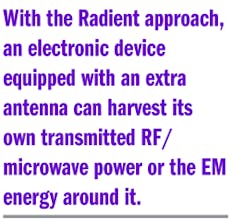This file type includes high resolution graphics and schematics when applicable.
Portable radios for tactical use have made tremendous strides in recent years. Borrowing from their commercial mobile wireless radio counterparts, they have added functionality while shrinking size and weight. But all of that communications capability can go to waste without power, and the last place to have a tactical radio’s battery power run low is on the battlefield.
This may soon be avoidable, however, with the adoption of energy-scavenging technologies that can transform available RF/microwave energy in the operating environment to dc power. To give one example, with the technology developed by Radient micro-tech Corp., the surface of a mobile electronic device—such as a portable tactical radio—can be transformed into a second antenna for capturing “free” power in the environment.
Part of Radient’s patented solution involves turning the surface of a cellular telephone or tactical radio into an energy-harvesting antenna. By doing so, the electromagnetic (EM) energy can be transformed into dc power and reused by the same or another electronic device. As much as 90% of the signal energy transmitted from a signal source, such as a cellular wireless base station, is dispersed into the environment and not used as part of the communications process.
The same is true for a tactical environment with wireless devices, such as tactical radios. If that energy can be captured, it can be reused to power multiple electronic devices. The Radient micro-tech technology allows users to charge the batteries of their mobile electronic devices from energy in the environment—or, in extreme cases, operate from that available energy and without a battery.
With the Radient approach, an electronic device equipped with an extra antenna can harvest its own transmitted RF/microwave power or the EM energy around it. The EM energy is converted to dc power, and then the electronic device’s power-management circuitry makes best use of the scavenged power. For example, it could be used to power some of a radio’s circuitry, saving its own battery power and extending operating time, or to charge the radio’s battery for additional operating time.
The concept of energy harvesting and reducing battery size for in-field electronic equipment has been of interest to researchers from the U.S. Army Material Command’s Communications-Electronics Research, Development, and Engineering Center (CERDEC) for some time. Portable radios, GPS receivers, and night-vision goggles are just a few of the electronic devices carried by a modern soldier, all requiring batteries.
In seeking to reduce the weight of the batteries required for all of these electronic devices, CERDEC and its Command, Power, and Integration Directorate has developed the Energy Harvesting Assault Pack (EHAP; see photo). It is designed to convert the natural movements of soldiers into usable electrical power.
The CERDEC EHAP consists of a rack-and-pinion generator with spring-loaded, double-frame suspension systems attached to a rucksack. The rucksack moves up and down with each step taken by a soldier, moving the generator and producing electrical energy. CERDEC is studying the impact of soldiers carrying the added weight of the EHAP frame, hoping to create smaller, lighter versions with improved energy efficiency. Certainly, energy-harvesting methods such as the Radient micro-tech solution are also of interest.
This file type includes high resolution graphics and schematics when applicable.




